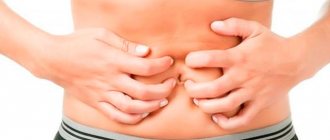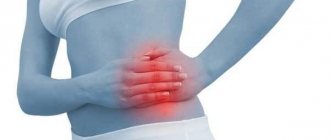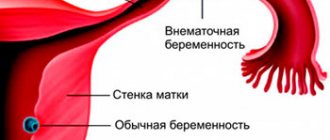23.12.2016
Candidiasis, the better known name of which is thrush, occurs from an excess of candida fungus that has entered the vaginal mucosa, but is most often located in the large intestine.
Although the fungus is constantly in the body, under specific conditions (weakened immunity, stress, hormonal instability, unhealthy diet, etc.) it can actively reproduce. At an appointment with a gynecologist, some women complain that the lower abdomen hurts due to thrush.
Pain in the lower abdomen with thrush is statistically rare, but it does happen. Fungal colonies, when spreading and living, cause discomfort, or even severe itching, but this is unlikely to be pain. So can thrush cause pain in the lower abdomen? Let's try to figure it out.
Causes of pain in the lower abdomen
In addition to the influence of Candida fungus, the causes of pain with thrush can be:
- Sexual intercourse in the treatment of thrush. Doctors advise abstaining from sex during treatment, and this recommendation is quite justified, because the vaginal mucosa in women is irritated, resulting in discomfort and pain in the lower part. Secretions are poorly produced during sexual intercourse, and the required amount of lubrication does not appear. Subsequently, long-term nagging pain occurs and a feeling of discomfort occurs in the lower abdomen. Another reason is that candidiasis can be transmitted to a partner.
- Pathologies or gynecological diseases. The development of these diseases does not depend on the presence of the fungus. For example, ovarian cyst, endometriosis, adhesions in the pelvis, cervical erosion, tuberculosis. In this case, you need to take special care of your health. If the lower abdomen hurts and feels tight, and the woman is aware of her possible diseases, then the pain may not disappear with the elimination of candidiasis. Therefore, go to the doctor. After all, such pathologies cause a lot of inconvenience, and after treatment for candidiasis, additional treatment will probably be required. Irritation of the vagina during urination and the spread of pain. With thrush, the mucous surface of the vagina is sensitive to any irritants and is especially inflamed. And if pain occurs when urinating, this indicates that the fungus is making its way into the urethra, which can lead to kidney damage and the development of cystitis.
- Provocation of pain is carried out by infections and bacteria of the genital tract. This can be done by ureoplasma, gonococci, trichomonas, chlamydia. Infectious diseases may be involved in the active development of the fungus, and even more so in the acute period. This applies to the adrenal glands, kidney diseases, colon, and bladder.
- Intolerance to the drug. The response to the medicine depends on the individual characteristics of each patient.
Pain in the vagina may be due to candidiasis
When a woman has a pain in her lower abdomen due to thrush, this is one of the reasons to immediately consult a doctor. Painful sensations are not a characteristic symptom of candidiasis. But don’t worry - pain can be of different types and from them you can form a complete clinical picture.
What will the article tell you?
Vaginal candidiasis is one of the most common pathologies. The causative agent is a fungus of the genus Candida. It is found in smears of a healthy person because it is part of the natural flora of the vagina.
Candida belongs to the category of opportunistic microflora. It begins to actively reproduce when favorable conditions are created. It is the excess of the fungus that leads to the development of the disease.
With candidiasis, women experience redness and itching of the vaginal mucosa. One of the characteristic signs is the appearance of a white coating on the surface of the skin. When it is removed, the itching intensifies and severe redness is detected. In advanced stages of the disease, bleeding ulcers may be observed at the site of the removed plaque. Pain due to thrush in most cases indicates the spread of infection.
Important! Self-treatment of thrush with improvised means can lead to the disease becoming chronic.
Vaginal candidiasis develops only when conditions favorable for this are created. In other cases, the growth of candida is regulated by natural microflora. Protection of mucous membranes from pathogenic microorganisms is due to evolution and helps a woman bear and give birth to a healthy child.
Disturbances of the natural microflora, weakening of the immune system, create favorable conditions for the development of thrush. To prevent this, it is necessary to minimize the impact of provoking factors:
- weakening of general immunity;
- taking oral contraceptives – causes changes in hormonal levels, which negatively affects the microflora;
- treatment with antibiotics - this group of drugs negatively affects not only pathogenic microorganisms, but also healthy flora;
- diabetes – characterized by a weakening of the protective functions of the entire body;
- sexually transmitted diseases - weaken local immunity, negatively affect the general condition of the immune system;
- intestinal infections - with insufficient hygiene, the pathogen can spread, which becomes the cause of complications;
- menopause - hormonal changes in the body negatively affect the healthy microflora of the vagina;
- insufficient hygiene – infrequent changes of linen, failure to comply with hygiene procedures, create favorable conditions for the development of infection.
Pain in the lower abdomen due to thrush in women appears mainly in cases where the pathology is complicated in some way . There are three types of candidiasis:
- Primary. Occurs in healthy women. It has characteristic symptoms and resolves without complications. Amenable to traditional treatment.
- Secondary. It develops against the background of a primary disease and can be its complication. In such cases, candidiasis develops more rapidly and is less treatable.
- Complicated. Against the background of primary thrush, other diseases develop. This is due, as in the case of the secondary type, to a weakening of local immunity. Secondary infection can affect the appendages, uterus, and ovaries. In this situation, pain in the lower abdomen is observed due to thrush in women.
Candidiasis can spread in several ways. But getting a fungus into the vagina does not guarantee infection - several months or even years may pass between infection and the development of the disease. The main routes of transmission of candida include:
- sexual contact with a sick person who is a carrier of the infection;
- oral sex - upon contact with a person whose candidiasis affects the oral mucosa;
- general use items - towels, washcloths, bed linen;
- swimming pools, baths, saunas - in case of insufficient water treatment, as well as when visiting a sauna or bathhouse together with an infected person.
Note! If the pathology occurs in a latent form and a woman does not have specific symptoms, she can still be contagious to others.
Almost 50% of adult women are familiar with the symptoms of fungal infection. The first signs appear within a few hours after the fungus spreads:
A day after the onset of the disease, the woman begins to develop a characteristic cheesy discharge that has a sour odor. Laboratory diagnostics reveal a large amount of fungus in them.
Important! Under no circumstances should you engage in self-diagnosis. Symptoms similar to candidiasis are characteristic of many sexually transmitted diseases.
Pain during thrush can be of different types. When visiting a doctor, it is necessary to clarify exactly where it hurts and how it hurts - this can significantly facilitate the diagnosis. Different types of painful sensations can mean damage to different organs and infection with different pathogens.
- When urinating
Emptying the bladder is one of the physiological ways to cleanse the mucous membrane. Urine contains urea, which has an antiseptic effect. If you experience pain while urinating, this may be a sign that an infection has spread to the urethra.
In such a situation, it is necessary to inform the gynecologist about this so that he can prescribe the appropriate treatment. Special antiseptic and antifungal drugs will help not only eliminate the fungus, but also reduce painful symptoms.
- During sex
Damage to the vaginal epithelium leads to pain due to thrush in women. Discomfort worsens during and after sexual intercourse. A characteristic feature of such a lesion is an insufficient amount of natural lubrication. Redness of the mucous membrane of the external genitalia is also noted.
If left untreated, symptoms may worsen over time. Painful ulcers appear on the surface of the epithelium. With insufficient treatment, Candida can spread to the cervix, uterus itself, fallopian tubes and ovarian appendages. This causes the development of an acute inflammatory process, which in the long term can lead to infertility.
When doctors ask if the stomach hurts with thrush, women primarily associate it with a nagging unpleasant sensation. Such pain appears with diseases accompanying thrush - endometriosis, endometritis, erosion, cysts in the ovaries.
Nagging painful sensations may indicate the presence of an inflammatory process. They can radiate to the sacrum, lower back, and significantly interfere with normal life. In such a situation, a visit to the doctor is required. The gynecologist will write a referral for an ultrasound to check the condition of the fallopian tubes and ovaries, and will also take a smear to determine the microflora.
Pain due to thrush in women, in most cases, indicates the presence of a complication. No need to worry - timely diagnosis and proper treatment will help eliminate the cause with a minimum of side effects. The most common causes of pain may be:
- vulvovaginitis is an inflammatory process affecting the vulva and vaginal mucosa;
- colpitis – inflammation of the vaginal mucosa;
- adneskitis - infectious inflammation of the ovarian appendages;
- cystitis - inflammation of the bladder;
- pyelonephritis – inflammation of the renal pelvis that occurs against the background of cystitis;
- endometritis – inflammation of the uterine endometrium;
- salpingitis - infectious inflammation of the fallopian tubes;
- Cervicitis is a lesion of the cervix.
With the transition of these diseases to the acute stage, characteristic symptoms appear:
- general weakness, lethargy, constant fatigue;
- decreased performance, decreased concentration;
- rise in body temperature to 39-40 C;
- chills;
- stool disorders, diarrhea;
- sharp pain in the lower abdomen;
- increased heart rate, frequent weak pulse.
When the doctor asks if your stomach hurts due to thrush, you must tell him about the presence of these signs. If left untreated, these pathologies may progress to the surgical phase and require complete removal of the affected organ.
A woman will need to pay attention to the presence of bloody discharge during the intermenstrual period - this is a clear sign of damage to the cervix. Through the cervical canal, candida can spread higher throughout all organs of the reproductive system, which will lead to acute inflammation.
If treatment is not provided within 10-14 days, in the absence of other diseases, the pathology becomes chronic. The disease will worsen with each decrease in immunity, which can lead to the development of an abscess.
When a woman has a stomach ache due to thrush, conventional painkillers will not be able to eliminate the cause of the problem. Therefore, the pain syndrome will become recurrent. To avoid this, it is necessary to properly carry out treatment, which will be aimed at eliminating the pathogen.
Available in capsules. Vaginal candidiasis requires a single dose of a capsule with 150 mg of active substance. Inhibits the proliferation of fungi, but does not affect secondary pathogens.
Available in the form of tablets, suppositories and ointments. It provides both rapid symptomatic treatment and effectively inhibits the proliferation of fungus. The course of treatment with Nystatin ranges from 7 to 21 days, depending on the degree of damage.
Release form: suppositories, tablets and cream for external use. Eliminates itching, inhibits the proliferation of fungal colonies.
Available in the form of suppositories, drops, ointments, suspensions, applications. Inhibits the growth of the pathogen. Prevents its further reproduction.
Additionally, the gynecologist may prescribe antispasmodics and nonsteroidal anti-inflammatory drugs (NSAIDs). They suppress the inflammatory process, reduce temperature in the acute stages of inflammation and eliminate pain.
It must be remembered that if a woman experiences abdominal pain during normal thrush, she should immediately consult a doctor. Timely initiation of treatment helps to avoid serious complications, one of which is infertility. Self-medication in this situation can lead to a worsening of the condition and the disease becoming chronic, which is much more difficult to treat further.
Based on materials from medicsina-blog.ru
According to statistics, every second representative of the fair sex has experienced stabbing pain in the vagina at least once in her life. There could be many reasons for this. Unpleasant sensations not only bring discomfort, but are also alarming, since they may indicate the presence of pathology. According to WHO, in the countries of the former Soviet Union, 25 percent of women have diseases of the genitourinary system, one of the signs of which is precisely such pain. A symptom may indicate the presence of infection, cysts, pathology of the uterus or its appendages, etc. Therefore, it is important to seek the help of a doctor in a timely manner; after carrying out diagnostic measures and making an accurate diagnosis, he will prescribe appropriate therapy. If it is not possible to visit a doctor at the moment, you can get a free consultation with a gynecologist by phone.
The nature of the pain may vary. The pain can feel like needle pricks and sometimes gets worse over time. Severe pain causes discomfort and forces you to change your body position. There may be a feeling of the presence of a foreign body and heaviness in the groin area. Also, discomfort may be accompanied by other symptoms:
- Pathological discharge. They may have an unpleasant odor and a yellow, brown or green tint.
- Heaviness in the abdominal area.
- Weakness and increased fatigue.
- Increase in body temperature.
- Development of bleeding.
If any of the signs appear, it is recommended to get a free consultation with a gynecologist by phone, or it is best to go to a medical facility in person.
In medicine, the reasons that can provoke the appearance of pain are conventionally divided into several groups. Thus, possible causes of stabbing pain in the vagina include:
- Development of infection.
- Mechanical damage to the mucous epithelium, injuries to the genitourinary system.
- Changing your diet.
- Wearing synthetic underwear.
- Pathologies of organs that are located nearby.
Most often, pain occurs due to the development of infection and various female diseases. This is due to the fact that the tissues and mucous epithelium of the vagina are quite thin, so they can change. The most common diseases that cause pain include:
- Colpitis. The pathology is manifested by inflammation of the vaginal mucous epithelium due to infections, tissue changes due to age, and damage. In this case, the woman experiences stabbing pain in the vagina, the causes of which will be accurately determined by a doctor, as well as swelling of the area, and unpleasant discharge with purulent contents. Sometimes the discharge may be mixed with blood. When diagnosing colpitis, maintenance therapy is carried out aimed at restoring microflora and increasing the body's defenses. The doctor often prescribes douching with antiseptic drugs.
- Bartholinitis. This pathology is an inflammation of the gland that synthesizes lubricant. Pain occurs in the perineal area, discharge mixed with pus, and swelling of the mucous epithelium may appear. Women may experience a rise in body temperature, chills and fever. Without treatment, an abscess begins. Treatment should be carried out with the use of antibacterial drugs, analgesics and antiseptics.
- Vaginitis has similar symptoms to colpitis.
Often the causes of stabbing pain in the vagina are associated with diseases of the genital organs. Typically, pain occurs during movement or sexual intercourse. Common diseases that cause pain include:
- Adnexitis. The pathology manifests itself in inflammation of the ovaries and fallopian tubes as a result of infection entering them. In addition to pain, the woman’s body temperature increases and pathological discharge appears. In this case, the gynecologist prescribes antibacterial drugs and a diet. During therapy you need to abstain from sexual relations.
- Erosion manifests itself in the expression of the mucous epithelium of the cervix. A woman experiences vaginal pain that radiates to the lower abdomen. During sexual intercourse, bloody discharge appears. Therapy is carried out surgically: cryotherapy, laser therapy, cauterization, etc.
- Metritis is characterized by inflammation of the muscle layer of the uterus as a result of infection. Symptoms of the pathology are: bleeding, increased body temperature, pain in the vagina after sex. Treatment involves the use of antibiotics and physical therapy.
- Endometritis and endometriosis provoke the appearance of pain, itching, and discomfort in the vagina.
Often, an infection that penetrates the genitals causes the development of diseases, for example, gonorrhea, herpes, chlamydia and other sexually transmitted diseases. They are often accompanied by pain, swelling, itching and burning in the vagina, and unpleasant discharge appears.
When there is a lack of lactobacilli in the vagina, pathogenic microflora actively multiply and bacterial vaginosis begins to develop. In this case, in addition to pain, copious discharge with an unpleasant fishy odor appears. Thrush (candidiasis) also provokes curdled discharge and stabbing pain.
Also, the cause of stabbing pain in the vagina can be an infection of the urinary system, for example, cystitis or urethritis. In this case, pain will spread to the perineal area.
Therapy for all these diseases is carried out using antibacterial drugs and antiseptics.
Often, damage to the vaginal mucosa provokes pain. This phenomenon can be observed, for example, with frequent douching. Typically, the gynecologist prescribes antiseptics and anti-inflammatory drugs for topical use.
Sometimes it stings in the vagina due to poor intimate hygiene. In this case, irritation of the mucous membrane develops, accompanied by itching, swelling and redness. The same symptoms can be observed when using synthetic underwear. In any case, it is necessary to follow the rules of hygiene and use antiseptic solutions as therapy.
With vaginal injuries, pain almost always occurs. After labor, cervical or vaginal rupture may occur. When applying sutures, it is often not possible to restore the anatomical integrity of the organs, so over time, scars remain, which sometimes provoke pain during sexual intercourse.
Many women complain of a tingling sensation in the vagina during pregnancy. This phenomenon can be considered normal, since the uterus during this period increases in size, and the walls of the genital organs are stretched. If discharge and negative symptoms appear, you should immediately visit a doctor for diagnosis.
There are women whose special gland produces an insufficient amount of lubricant, so during sexual intercourse dryness, irritation, microcracks and pain appear. This phenomenon can also be triggered by a lack of sexual arousal or stress. Doctors recommend in such cases the use of special lubricants, which can be purchased at almost any pharmacy. It is also recommended to visit a gynecologist to identify the causes of pain.
Sometimes women may develop a cyst on the ovary. This neoplasm often occurs as a result of blockage of the gland that synthesizes lubricant. In this case, surgery is performed.
In some cases, polyps appear in the uterus; the reasons for this phenomenon may be different, but most often this is facilitated by a violation of the hormonal system. Doctors include the development of adnexitis and endometritis, as well as abortion, as predisposing factors.
The main cause of polyps in the uterus is the synthesis of large amounts of estrogen, which stimulates the enlargement of the endometrium. As a result, growths appear, which are called polyps.
Such pathologies are often accompanied by pain, bleeding, bleeding, and infertility. Treatment is expected to be surgical.
Under the influence of negative factors, the structure of the genital organs may undergo changes. The walls of the vagina may become thinner or thicker, and they may droop, especially during labor complications. In this case, drug treatment with the use of hormones is carried out, sometimes surgery may be required.
As a woman ages, certain changes occur in her body. Sex hormones are synthesized in insufficient quantities, which can cause the development of kraurosis of the vulva, when the vaginal mucous epithelium atrophies. In this case, a stabbing pain may also appear.
In some cases, the causes of stabbing pain in the vagina have nothing to do with gynecology. Sometimes this syndrome can appear in the following cases:
- Constipation. In this case, pain in the intestines can radiate to the vagina.
- Bladder pathologies can also cause pain, which is often confused with vaginal pain. In such situations, pathologies are often accompanied by symptoms such as urinary disturbances.
- Damage to the lower parts of the spine provokes the appearance of pain in the lower back, in the anus and vagina.
It is very difficult to independently identify the cause of pain, so it is recommended to visit an experienced specialist. He will conduct diagnostics and make an accurate diagnosis. Diagnostic measures include:
- Collecting anamnesis, studying symptoms, interviewing the patient.
- A gynecological examination makes it possible to identify the presence and nature of discharge, determine the presence of neoplasms, erosion, and the source of inflammation.
- Laboratory tests, which include the study of blood, urine, smears.
- Instrumental examination methods, for example, ultrasound of the pelvic organs.
Based on the results of the examination, an accurate diagnosis is made and a treatment regimen is developed.
Pain in the vagina is not treated, treatment is carried out for the underlying disease that caused the appearance of such a syndrome. The treatment regimen is prescribed in each specific case based on the disease, age and individual characteristics of the patient’s body. In some cases, the doctor prescribes antibacterial drugs, antiseptic douching solutions, and hormonal agents. In other cases, surgery may be required.
Doctors strongly recommend not to self-medicate, as this can only worsen the problem. It is unacceptable to use heating pads or prescribe medications on your own. Treatment should only be carried out by a doctor. When the first unpleasant symptoms appear, you need to go to the clinic. Otherwise, complications may arise. Thus, in the absence of therapy, bartholinitis can provoke the appearance of cysts, and endometriosis can cause a cancerous tumor.
For the purpose of prevention, it is recommended to monitor intimate hygiene, have one sexual partner, and lead a healthy lifestyle. If unpleasant symptoms appear, you should immediately contact the clinic for diagnostic measures. Timely therapy will not only get rid of the pain syndrome, but also the cause of its occurrence.
Thus, it is impossible to identify the cause of pain on your own; this should be done by a doctor. Once an accurate diagnosis is made, effective treatment is developed that is aimed at eliminating the pathology. Sometimes the participation of specialists such as a urologist, neurologist or proctologist may be required, since pain may not always be caused by female diseases.
Based on materials from fb.ru
Thrush is known to many women for its unpleasant symptoms, which develop against the background of reduced immunity, hormonal imbalance, antibiotic use, dysbacteriosis, and others. These most often include cheesy discharge, itching and burning in the vagina, discomfort during sexual intercourse, etc. As a rule, this disease does not pose a health hazard and responds well to treatment, especially in the initial stages.
Rarely, but still some patients begin to experience pain in the lower abdomen. Such a symptom usually becomes a consequence of the development of an underlying disease or occurs when the development of candidiasis is influenced by a serious phenomenon. How dangerous is this phenomenon, and what causes it?
Thrush itself is, so to speak, a harmless disease that can be cured in a short time. The main conditions for treatment in such cases are timely treatment and strict adherence to all the doctor’s instructions.
According to the results of research and observations of gynecologists, pain due to thrush is very rare. As a rule, the proliferation of fungus in the vagina only leads to unpleasant sensations. The development of more serious symptoms is usually influenced by the transition of candidiasis to a chronic form or the manifestation of various kinds of complications. The influence of external factors can also provoke the appearance of painful sensations in the lower abdomen . The main thing is to seek help from a specialist in such a situation in time, since self-medication can lead to even greater health problems.
So, the main causes of pain include:
- developing against the background of gynecological diseases (cervical erosion, polycystic disease, endometritis, etc.);
- diseases of the genitourinary system developing against the background of candidiasis;
- irritation of the inflamed vaginal mucosa with urine;
- intolerance to a drug prescribed for thrush;
- sexual activity during therapy;
- a consequence of exposure to another disease that is not associated with candidiasis (which was not previously known) - in this case, pain is mistakenly considered a symptom of thrush.
Each of these factors can cause pain. It is necessary to consider in more detail the individual reasons causing their occurrence.
The proliferation of the fungus in itself does not lead to complications and the appearance of new sores. However, against the background of an exacerbation of the chronic form of candidiasis, complications may appear in the woman’s genital area, which cause the pain in question. In this case, it is important to contact a gynecologist in time, without attributing their appearance to thrush. Incorrectly selected therapy for any existing genital disease also leads to painful sensations.
There are also situations where the inflammatory process on the mucous membrane can aggravate the course of already known gynecological problems. During this period, the doctor should pay special attention to selecting the correct comprehensive course of treatment. Often, pain appears during an exacerbation of cervical erosion, which can begin along with candidiasis, as well as with an ovarian cyst. If you are aware of these diseases, you should immediately seek a change or adjustment of the course of previously prescribed therapy.
It is important during periods of exacerbation of illnesses to strictly follow all the doctor’s instructions, since neglect of this matter can greatly worsen the situation. With regard to thrush, time plays an almost decisive role. Minor symptoms can become a permanent part of your life if not treated promptly.
Pain with thrush in the abdominal area can be a consequence of the development of complications in the genitourinary system . This is observed in cases where the fungus, during the process of reproduction, penetrates into other internal organs. Since the organs of the genitourinary system are the first on the way, most complications are observed in this area.
This phenomenon is often accompanied by sharp pain when urinating, which, in turn, can spread to the lower abdomen. In this case, the last symptom is mistakenly taken as a consequence of candidiasis. This definition is considered incorrect due to the fact that the effect of the fungus on various organs does not lead to painful sensations, but only provokes the development of other background diseases. Exposure to the genitourinary system of Candida can cause cystitis, urolithiasis, as well as problems with the adrenal glands and kidneys. The progression of thrush can be aggravated by the entry of microorganisms into the urethra.
In this case, the gynecologist, who you should contact first, will refer you for an appropriate examination to a therapist or urologist. Further treatment will be agreed upon by different specialists as a comprehensive approach.
A common symptom of candidiasis is pain during sexual intercourse in the vaginal area. Along with this, after sexual intercourse, characteristic painful sensations in the lower abdomen may appear. This is due to the fact that during periods of increased fungal activity, the vaginal mucosa becomes inflamed and becomes more sensitive. Any external intervention can cause discomfort and lead to the symptom in question.
The discomfort may be aggravated by the presence of any erosive changes or ulcers on the mucous membrane. The disease itself can negatively affect the production of secretions, which is also observed in the use of certain medications (suppositories, medicinal tampons, douching solutions, etc.). Lack of lubrication during sexual intercourse also leads to painful sensations. After sexual intercourse, they can turn into nagging pain. It is because of these facts that doctors recommend abstaining from sexual contact during therapy.
It should also be mentioned that the pain caused by these factors does not differ in duration. After stopping sexual intercourse, they should soon disappear. If this does not happen, or the painful sensations periodically reappear, then you should immediately go to a gynecologist for advice.
Only an appropriate specialist can prescribe a course of drug therapy after examining and determining the causes of pain. On your part, you need to adhere to a number of rules and recommendations that will lead to a speedy recovery:
- If new, previously unfamiliar symptoms appear, immediately seek medical advice.
- During the treatment period, refrain from sexual intercourse to avoid worsening of painful sensations.
- Treatment of candidiasis should be carried out in both partners at once.
- Follow the rules of personal hygiene, as well as the doctor’s recommendations in this area (for example, do the prescribed douching in a timely and regular manner, refrain from using intimate hygiene products that irritate the vaginal mucosa, etc.).
- Conduct additional research in a timely manner to determine the development of complications in other organs.
If you adhere to any folk remedies in your therapy, then you should immediately warn about the dangers of self-medication . Without knowing the cause of pain in the lower abdomen, it is difficult to choose the right remedies. If you start this process, you can cause the development of many complications.
As you can understand from what you read, painful sensations in the lower abdomen are not typical for candidiasis. They always appear against the background of exposure to external factors or against the background of complications. If this symptom occurs, you should immediately seek medical help. Only he will be able, based on the results of additional studies, to find out the cause of pain and prescribe adequate treatment.
Based on materials from jetem.me
Symptoms of thrush
The lower abdomen can also hurt due to the activity of candida fungus. In this case, active discharge from the genital organs occurs. This is an indicator of the inflammatory process that began in the vagina. At the first such symptoms, consult a doctor immediately.
White or white-gray discharge looks like a cheesy mass with a hint of sour odor. In this case, the genitals become irritated and itchy, causing a lot of inconvenience.
If thrush has been present for quite a long period of time, and is not treated in any way, then erosion of the cervix and inflammation in the appendages are possible.
Symptoms also depend on the severity of the pathological process. If it is slightly expressed, then only pain and discharge are of concern. With a strong pathological process, the appendages become inflamed due to active infection in the genital tract.
Pain can be general and local (local). General pain is quite severe and occurs in the pelvic area. In this case, the body temperature rises significantly, and in most cases it hurts on both sides and in the sacrum area. This is accompanied by headache, sweating, vomiting and muscle pain.
Local pain with thrush is nagging and aching in nature, accompanied by white or purulent discharge from the vulva. In this case, a malfunction of the appendages in the uterus occurs.
Pain from thrush in the lower abdomen can occur in cases of antibiotic treatment, lack of vitamins, infection, or a reduced level of body resistance. It can also be weak, radiating to the lumbar region, due to the fact that the inflammation occurs in an almost imperceptible mild form. Such pains do not particularly bother the woman, and because of this, a trip to the doctor for examination and consultation is delayed for months, and maybe even years.
Such disregard for the health of the genital organs leads to serious consequences, because thrush progresses and can reach a chronic form of the disease, which ultimately becomes the cause of infertility. In the first stages, thrush can be eliminated within one to two weeks of therapy, so it is better to visit a gynecologist in a timely manner than to eliminate the consequences.
Features of the disease
Thrush is an infectious disease of the genital tract caused by the proliferation of a fungus of the genus Candida. This pathogen is part of the opportunistic microflora of the vagina. It lives on the mucous membranes of most healthy people and does not cause the development of pathology. However, the influence of certain factors creates conditions favorable for its growth. In this case, a disease develops - candidiasis (thrush).
Factors contributing to the development of the disease:
- decreased immunity (immunodeficiency states, recovery period after an acute illness, chronic diseases);
- changes in hormonal levels (pregnancy, diseases of the endocrine system, menopause, taking oral contraceptives, hormonal therapy);
- unprotected sexual intercourse;
- diseases of the genital organs, especially infectious ones;
- diseases of the blood and hematopoietic organs;
- hypothermia;
- taking antibiotics;
- poor nutrition: excess intake of sugars or deficiency of vitamins and microelements.
Vaginal candidiasis is characterized by itching, burning in the perineal area, discharge with a sour odor, has a cheesy consistency, and is white or yellowish in color. The act of urination is accompanied by pain and burning in the urethra. During the examination, swelling and rash are detected on the vaginal mucosa. With advanced thrush, erosions may form. The presence of pain in the lower abdomen with thrush indicates the formation of an inflammatory process in the genitourinary system.
Causes not related to thrush
The lower abdomen may become ill due to the acute manifestation of premenstrual syndrome.
Lower abdominal pain can also be caused by endometriosis. This disease is characterized by the spread of endometrial tissue in inappropriate places. The tissue passes into the abdominal cavity from the uterus, which is the cause of the pain of a pulling and aching nature. The initial stage of the pathology is characterized by small amounts of blood discharge, which is similar to menstruation.
Keep in mind:
- The nagging and aching pain in the lower abdomen will not go away on its own. Visit a doctor at the first symptoms - he will prescribe the appropriate tests, necessary procedures and drug therapy. Don't wait until you can no longer bear the pain.
- Strictly follow all doctor's recommendations and completely avoid sexual intercourse during candidiasis.
- It is necessary to maintain personal hygiene, do not use soap and concentrated shower gels that irritate the mucous membranes. It is worth douching and following the doctor’s recommendations.
Signs of salpingitis
Salpingitis is an inflammation of the fallopian tubes. The disease develops as a complication of chronic thrush or a mixed type of infection. Fungi enter the appendages through the cervical canal and the uterine cavity. The mucous membrane of the tubes is damaged; as the disease progresses, adhesions form and peristalsis is disrupted.
The pathological process can cause ectopic pregnancy or infertility due to tubal obstruction. The accumulation of purulent masses in the lumen of the tube leads to the formation of an abscess requiring surgical treatment.
Salpingitis caused by long-term thrush manifests itself:
- acute pain in the lower abdomen, radiating to the lower back and rectum;
- high body temperature;
- chills, malaise;
- frequent, loose stools;
- sharp pain during sexual intercourse;
- copious whitish vaginal discharge.
As the purulent process develops, the secretion acquires a yellow-green color and a pungent, fetid odor. Difficulty urinating and bowel movements. Urine is released in small portions.
https://youtu.be/F-zVOgoQc44
Treatment of thrush
Even if thrush has already been cured and you are familiar with its symptoms, you should not delay visiting a gynecologist. He will establish an accurate diagnosis, excluding sexually transmitted diseases that you may have contracted.
An accurate diagnosis is the key to correct and, most importantly, effective treatment. Before going to the doctor, you need to carry out a number of procedures:
- Avoid sexual contact.
- Use furatsilin solution to relieve pain and disinfect.
- Swim frequently using special intimate hygiene products.
- Priority is given to the consumption of vegetables, fruits, dairy products and cereals.
- Eliminate sugar, vinegar, beer and baked goods from your diet.
If the gynecologist is smart, he will easily prescribe you the correct and necessary treatment, depending on the causes of pain and test results. And if you want to get rid of pain in the lower abdomen, then just follow his recommendations.
Both partners need to treat candidiasis - without this, the risk of recurrent disease increases significantly. In addition to medications prescribed by a doctor, it is worth undergoing physical procedures.
Traditional methods
Traditional medicine is used as an additional remedy and should not be neglected.
A soda bath helps relieve pain. But keep in mind that it can cause harm to the vaginal mucosa. One teaspoon of soda is enough for a liter of warm boiled water. Leave in the solution for twenty minutes, and after a day increase the dose by adding a liter of boiled water and a teaspoon of iodine solution.
Drinking carrot juice is also popular. You should take it one and a half glasses before meals, and you should drink it for several weeks.











